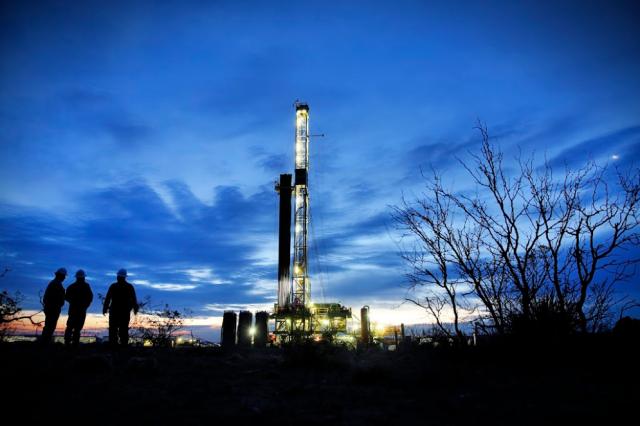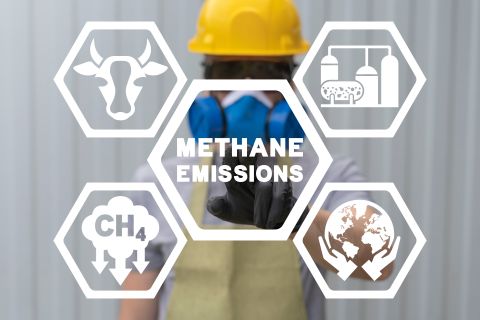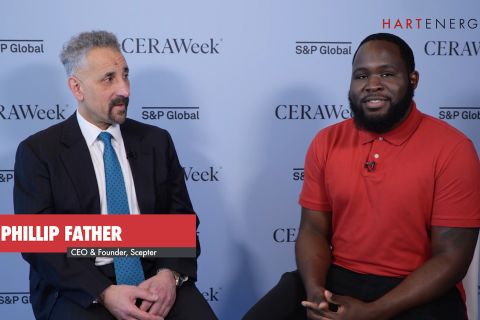
Diamondback Energy has more than 342,000 net acres located in the Midland and Delaware sub-basins plus over 7,600 net horizontal locations, according to a recent investor presentation. (Source: Hart Energy)
After a rough third-quarter 2019, Diamondback Energy Inc. finished the year strong after an issue with frac hits hamstrung the company’s oil production in the Permian Basin last quarter.
“The impact of offset frac interference experienced in the third quarter subsided in the fourth quarter with field-level production in Howard County [Texas] rebounding as expected,” Diamondback CEO Travis Stice said in a statement on Jan. 7.
Diamondback reported average daily production for fourth-quarter 2019 of 301,300 barrels of oil equivalent per day (boe/d), up from the previous quarter’s 287,100 boe/d and above Street expectations. Year-over-year, the company’s average daily production rose 65%, according to a company news release.
In particular, Diamondback returned to oil production growth after a dip in the third quarter. The company achieved oil production of 195,000 barrels per day (bbl/d) for the fourth quarter, which Stice said represented a roughly 5% sequential oil growth that set Diamondback up well for its 2020 plan.
“With the focus now on 2020, we believe Diamondback is well-positioned to execute on our previously announced plan to deliver 10%-15% year over year oil growth while generating robust free cash flow at current commodity prices,” he added in his statement.
RELATED:
Diamondback Steps Up Co-development In Permian Basin, Discusses Frac Hits
Gabriele Sorbara, an analyst with Siebert Williams Shank & Co. LLC, expects the news to be viewed positively and for Diamondback’s shares to outperform following the update on production.
“We reaffirm our Buy rating, and [Diamondback Energy] remains a top pick as it continues to screen with an attractive valuation coupled with a strong free cash flow generation/yield in 2020 and beyond, which should drive a healthy total return,” Sorbara wrote in a Jan. 7 research note.
In the third quarter, Diamondback saw its profit fall 13% from a drop in production, which it attributed to fracking by offset operators. Shares of the company also fell about 14% following announcement of the results.
“The combination of Diamondback frac activity and offset operators both to the east and west of our leasehold cut production in half for over 20,000 gross barrels of oil per day during portions of the quarter,” Stice said during the company’s earnings call in November.
While the company has dealt with fracking hits in the past, on the call Adam Lawler, vice president of investor relations, described the third quarter as “extraordinarily difficult” for Diamondback. He noted the company’s acreage in Howard County where another operator to the east had a 24-well pad with a frac spread on site for two and a half months during the quarter.
Well spacing has been an issue for some in the basin. Many shale players have targeted higher production by placing wells closer together. But that has resulted in less output, in some instances, leading to more conservative spacing—at least for those with available acreage.
Moving forward, Stice said the company would model production more conservatively, while also assuring analysts on the call that wells which experienced frac hits recover to peak production.
“These are operational challenges, not reservoir problems,” he said.
For 2020, Diamondback aims to produce between 310,000 and 325,000 boe/d. This includes 205,000 to 215,000 barrels bbl/d of oil with capex between $2.8 billion and $3 billion spread across its position in the Permian Basin.
Diamondback has more than 342,000 net acres located in the Midland and Delaware sub-basins plus over 7,600 net horizontal locations, according to an investor presentation from November.
The large-cap E&P has largely been known as a consolidator in the Permian Basin. Throughout the years, Diamondback has agreed to acquire multiple Permian operators, with its merger with Energen in 2018 being its largest acquisition so far.
At the time, the company expected the $9.2 billion all-stock acquisition (including debt) of Energen would add critical mass that would turn Diamondback into a true manufacturing business. On Jan. 7, Stice said Diamondback ended last year reaching that target.
“Following our recent investment grade upgrade and debt refinancing, Diamondback ended 2019 meeting or exceeding every major synergy target laid out with the Energen transaction,” he said in his statement. The Energen transaction closed Nov. 29, 2018.
Recommended Reading
Qnergy Tackles Methane Venting Emissions
2024-03-13 - Pneumatic controllers, powered by natural gas, account for a large part of the oil and gas industry’s methane emissions. Compressed air can change that, experts say.
A Different Way to Approach Energy Industry Hiring
2024-02-07 - Modern energy companies have embraced competitive efficiency, cutting-edge innovation and ESG transparency. It is time for modern energy hiring to do the same.
Women in Energy: Here’s to Ms. Flat-Bottomed Paper Bag Inventor
2024-03-10 - A salute to the women of genius, including ‘Ms. Plain English Computer Language Inventor’ and ‘Ms. Parity is Not Conserved in Weak Interaction Discoverer.’
MethaneSAT: EDF’s Eye in the Sky Targets E&P Emissions
2024-03-07 - The Environmental Defense Fund and Harvard University recently launched MethaneSAT, a satellite tracking methane emissions. The project’s primary target: oil and gas operators.
Exclusive: Scepter CEO: Methane Emissions Detection Saves on Cost
2024-04-08 - Methane emissions detection saves on cost and "can pay for itself," Scepter CEO Phillip Father says in this Hart Energy exclusive interview.





